One of the many fascinating aspects of the Balinese culture is the recording of sacred knowledge onto miniature manuscripts known as the lontar. Characters scribed with a sharp instrument into dried palm leaves are then rubbed with hazelnut containing a black dye. The access is removed, revealing fine graphic lines upon the pale beige coloured leaf.
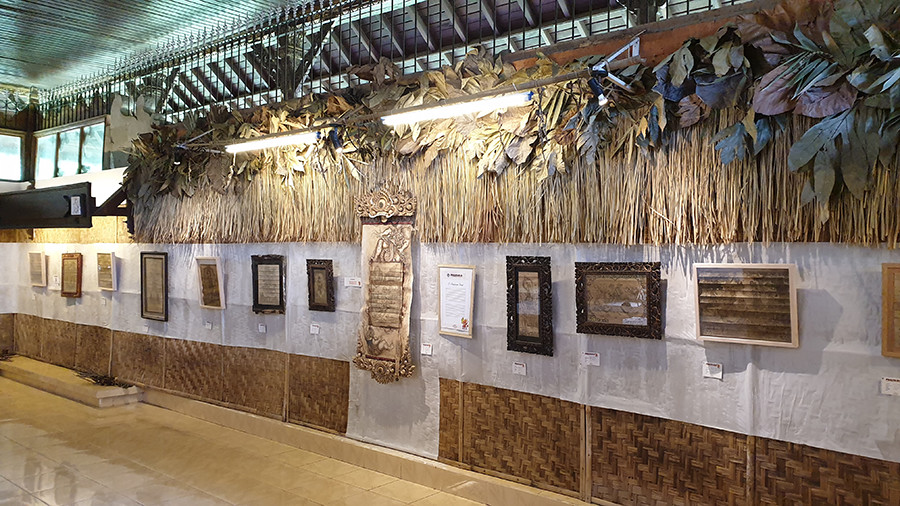
The strong and flexible leaves of the ental palm (Barasus Flabellifer) have numerous purposes, including plaited mats, ornaments and ritual tools and have been used as a medium to store information dating back to the 14th-century. The subjects described upon the leaves, measuring about twenty-five centimetres long, cover various aspects of human life. They are classified as: Weda – holy books, Agama – religious rules, laws, regulations, ethics and morals, Usada – homoeopathy and healing, Wariga – astronomy and astrology, Itahasa – epics including literature, Babad – history & genealogy, Lelampahan –the performing arts, Tantri – stories and notes, and Prasi –illustrations.
‘Prasara Prasikala Nukilan Taru Mahottama’, an exhibition of eighty-nine works of Prasi lontar by sixty Balinese and Indonesian artists from across the generations, was held in the Kryiya Hall at Taman Budaya Bali Art Center, Denpasar 1 – 28 February 2021. In a celebration of the art form, the exhibition included a seminar and workshop featuring the leading authorities from around the island as a part of Bulan Bahasa Bali 2021 (Balinese Language Month), a new annual program initiated by the Cultural Office of the Provincial Bali Government.
You may also like: Bali’s Lontar Museum : Library of Ancient Wisdom
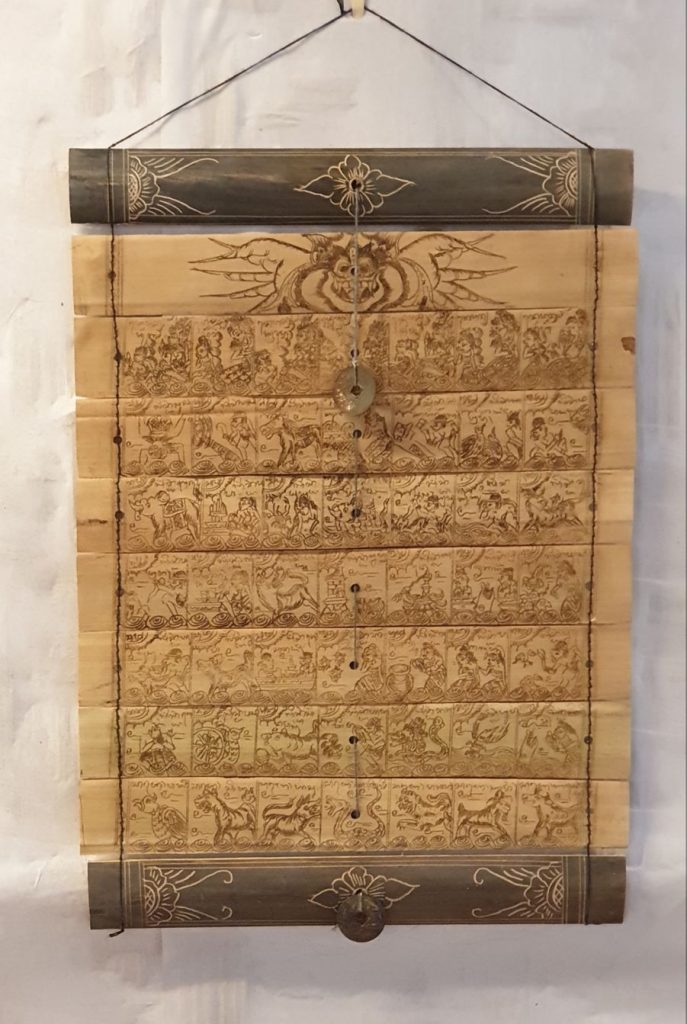
“The culture of lontar Prasi is experiencing significant developments, and there is a growing interest in collecting the artform locally and internationally. The exhibition will encourage appreciation and dialogue about the medium. It highlights diverse perspectives of the participating artists,” said Dr Wayan Kun Adnyana, Head of the Cultural Office of Provincial Bali. “The tradition continues to be strong, with new generations combining the old visual patterns with the new; virtual technology now allows the dynamic and more effective presentation of the medium to a growing audience.”
Arranged in chronological order, the exhibition revealed the historical development of the technique. It included new and older works from Taman Budaya and the Lontar Documentation Center Disbud Provincial Bali Government.
The visual content began with the Weda and Agama’s sacred images to the Wariga categories, featuring beautiful horoscopes and birth charts, Palinlangtangan, providing descriptions and ancient text defining the characteristics of individual days upon the calendar. The animated characters of the Wayang helped narrate stories from the sacred Hindu and Buddhist texts, the Ramayana, Mahabharata, the Sutasoma. These works were by artists of the senior generations, some celebrated icons of the art form, and male and female artists many years their junior from the next generation and academically trained.
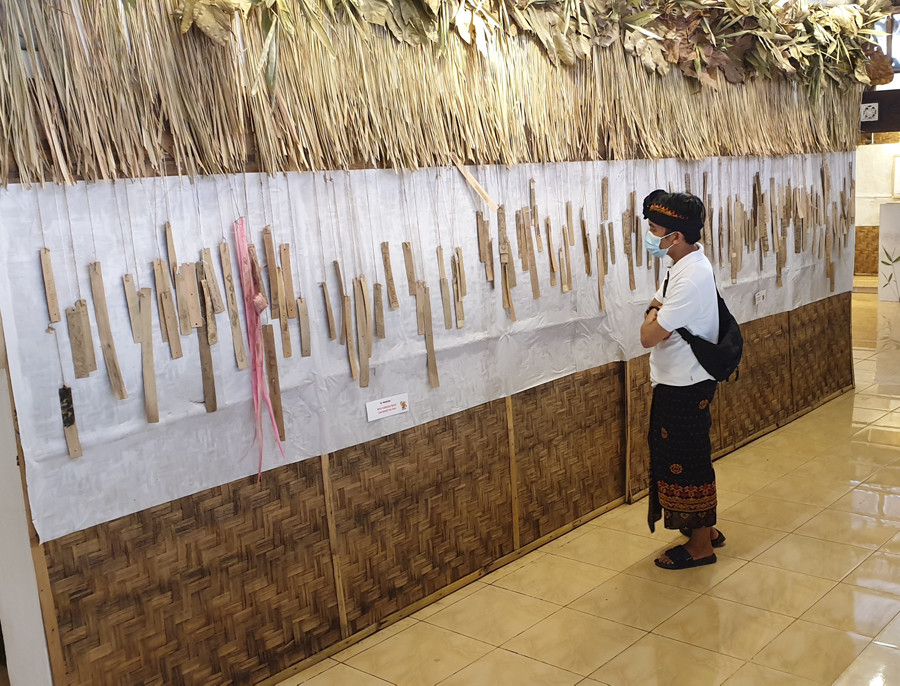
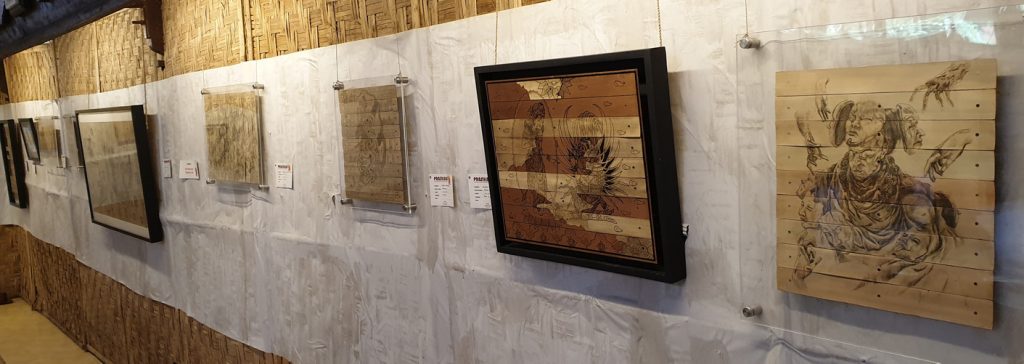
The aesthetics then leapt into the contemporary era with the recently developed comic format by students aged as young as twenty from the art colleges ISI Denpasar (the Indonesian Art Institute) and the UNDIKSHA University in Singaraja, North Bali. Recorded in different visual genres, the stories were described in Japanese Manga influenced imagery, realism and simplified and naïve styles. The picture stories ranged from organic farming in ‘Wayang Hero’ by Kadek Dwipayana to Balinese fables.
At the same time, I Made Wijana in ‘Melawan Corona’ 2021 described the use of local herbs as a remedy to the Corona Virus. New and unconventional decorative methods of presentation revealed the younger generations freedom of expression. Some utilised colourful acrylics to highlight carved bamboo frames. Cokorda Alit Artawan in ‘ Geseng Tenung’ 2021 presented an elaborate work with a carved wooden frame containing an illustrated canvas along with his lontar images.
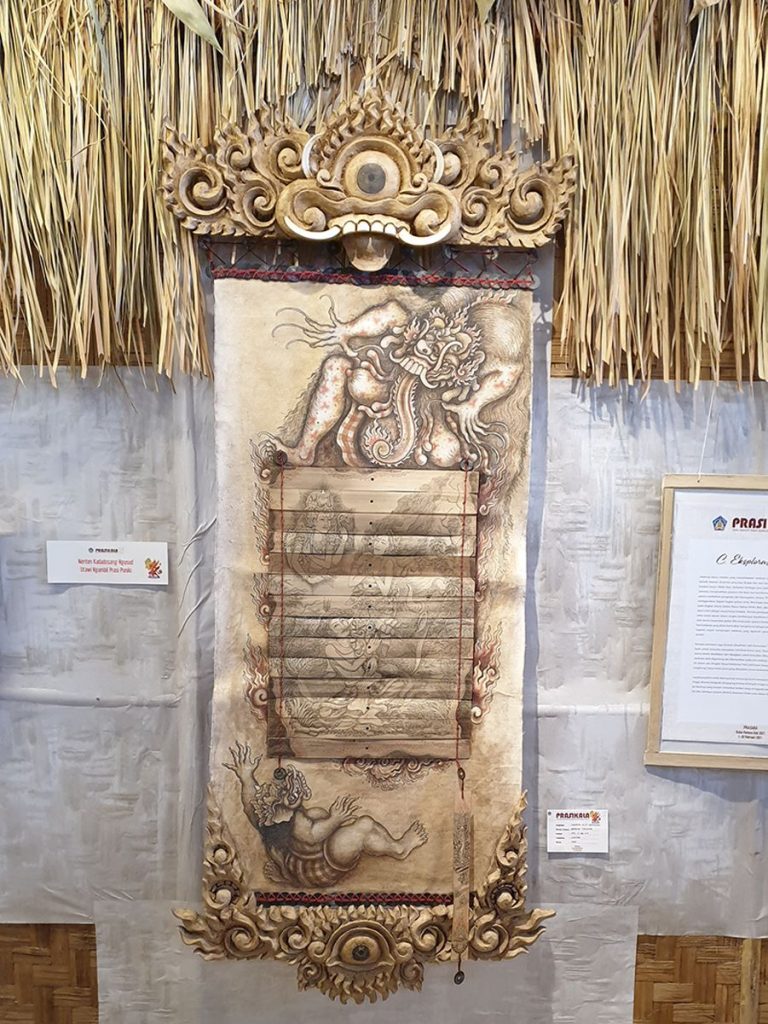
Works describing Prasi potential were on display from two of the village art epicentres. Sidemen in the central mountains of Bangli and the Bali Aga people from Tenganan, East Bali, who predate the East Javanese Majapahit Empire aristocracy who fled to Bali. Exhibited works came from both the academic and self-taught spheres. Ida Bagus Djelantik Purwa presented highly detailed portraiture. Also, modern art genres were depicted.
The exhibition’s distinguishing element was the new expression of leaves structured within two large-scale installations by contemporary artists responding to the medium beyond its conventions and displayed outside the exhibition pavilion entry.
An audience participation element welcomed visitors to experiment with the traditional scribing tool, pangrupak and create and colour their designs. Vastly different from working on paper, the challenging technique immediately instilled greater appreciation and respect for the artists presented within the exhibition. These works are signed and hung within a collective installation, being an unusual feature of the show.
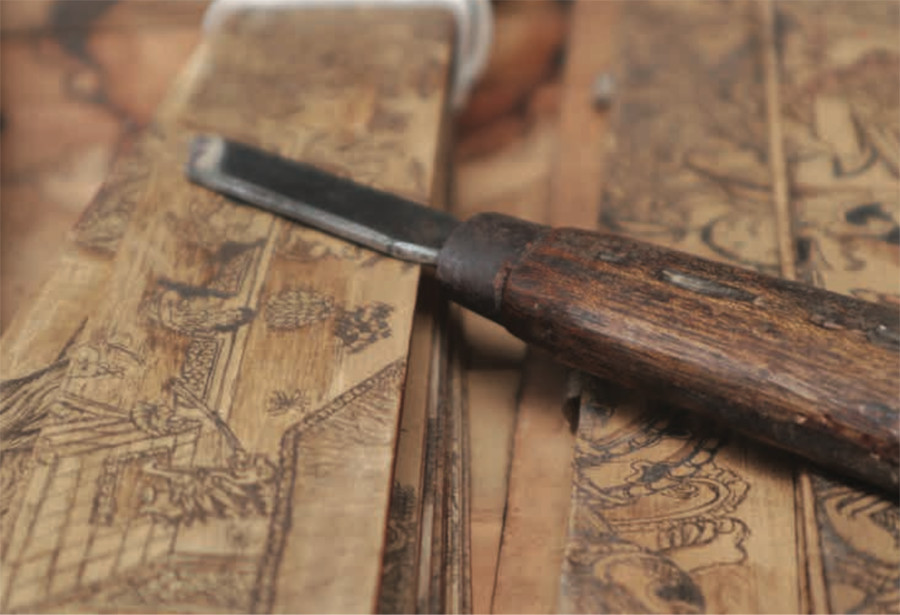
The seminar ‘Prasikala Taru Mahottama: Nukilan Rupa Wana Mukti’ held on 12 February investigated various topics as an educational resource presented live online via Zoom for artists, academics and the curious. The workshop led by artist I Gusti Bagus Sudiasta and lecturer Drs. I Wayan Suardana. The workshop ‘Pamelton Penguruk Ring Ental’ led by I Gusti Agung Ngurah attended by over twenty male and female students was held on 21 February at Gedung Kriya, Taman Budaya Art Center.
“Changes in the community’s social, economic, and cultural values have contributed to the emergence of new forms and themes of lontar prasi. ‘Prasara Prasikala Nukilan Taru Mahottama’ its seminar and workshop allows practitioners and academics to include content in their courses to maintain the tradition through its development,” said exhibition senior curator Wayan ‘Suklu’ Sujana, a lecturer at ISI Denapasr and a leading contemporary artist, who was assisted by five others in the role.
“The birth of new thinking, visual forms and presentations, along with the development of two Prasi communities, ‘Operation Community’ consisting young graduated from UNDIKSHA University and ‘Amarasi Community’ consisting of ISI Denpasar students suggests an exciting future for the genre.”
Written by Richard Horstman, Bali art expert, at lifeasartasia.art and on Instagram @lifeasartartasia.






